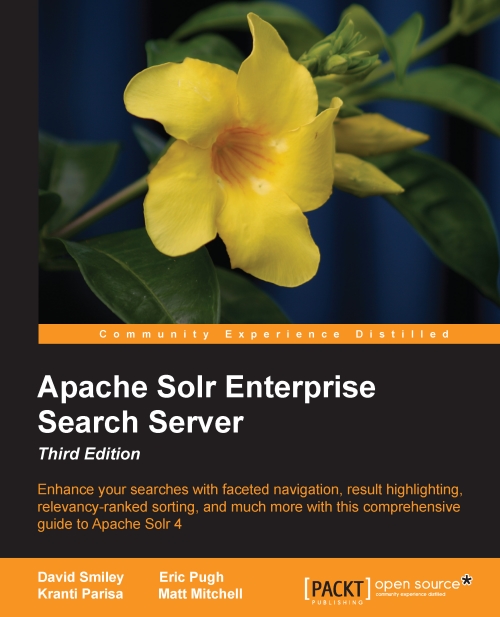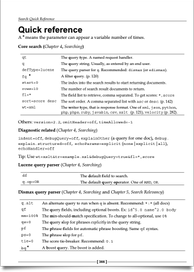
432 Pages
Published May 2015
Authors: David Smiley, Eric Pugh, Kranti Parisa, Matt Mitchell
Where to purchase?
Available from
For more info
Apache LuceneApache Solr
Get in touch with us
David SmileyEric Pugh
Kranti Parisa
Matt Mitchell
Welcome to the website for the book Apache Solr Enterprise Search Server, Third Edition
Here you can download the software and data developed for the book, as well as the appendix — a quick reference to common Solr parameters. This is the same that Packt makes available, but the download is more reliable via Amazon S3 links here. If you want the files for the previous editions of the book, we have them here too.
Preface
If you are a developer building an application today, then you know how important a good search experience is. Apache Solr, built on Apache Lucene, is a wildly popular open source enterprise search server that easily delivers the powerful search and faceted navigation features that are elusive with databases. Solr supports complex search criteria, faceting, result highlighting, query-completion, query spellcheck, relevancy tuning, and more.
Apache Solr Enterprise Search Server, Third Edition is a comprehensive resource to almost everything Solr has to offer. It serves the reader right from initiation to development to deployment. It also comes with complete running examples to demonstrate its use and show how to integrate Solr with other languages and frameworks — even Hadoop.
By using a large set of metadata, including artists, releases, and tracks, courtesy of the MusicBrainz.org project, you will have a testing ground for Solr and will learn how to import this data in various ways. You will then learn how to search this data in different ways, including Solr's rich query syntax and boosting match scores based on record data. Finally, we'll cover various deployment considerations to include indexing strategies and performance-oriented configuration that will enable you to scale Solr to meet the needs of a high-volume site.
Solr 4 or Solr 5?
Apache Solr 4.8.1 is officially the version of Solr this book was written for. Nonetheless, some of the features are discussed or referenced in the later versions of Solr as far as 5.0. In fact, Chapter 1, Quick Starting Solr, orients you to Solr 5, which has a different first-impression experience than its predecessor. Once you get Solr running, you should be able to follow along easily with Solr 5. In Chapter 10, Scaling Solr, there are some SolrCloud startup commands that are a little different, and we've pointed out how they change. The only substantial topic not covered in this book that evolved through the Solr 4 point releases is data-driven schemaless mode, and HTTP API calls to make schema changes.
How this edition has improved
Solr 4 was Solr's biggest release ever. We updated the previous edition to cover Solr 4, and some of Solr 5 -- particularly the part of Solr 5 that needs to be covered most, the bin/solr script. Chapter 9, Integrating Solr, now covers Hadoop integration, and better covers SolrJ. Chapter 3, Text Analysis, introduces various approaches for implementing Multilingual Search in your applications. And we think you'll appreciate the enhanced coverage of the topic of query auto-suggesters (AKA query completion) in Chapter 8, Search Components -- a feature that is important to most search applications. This edition has two additional authors, Kranti & Matt, who add their perspectives based on their experience working with Solr for a long time.
Who this book is for
This book is primarily for developers who want to learn how to use Apache Solr in their applications. Only basic programming skills are assumed, although the vast majority of content should be useful to those with a solid technical foundation that have not yet programmed.
